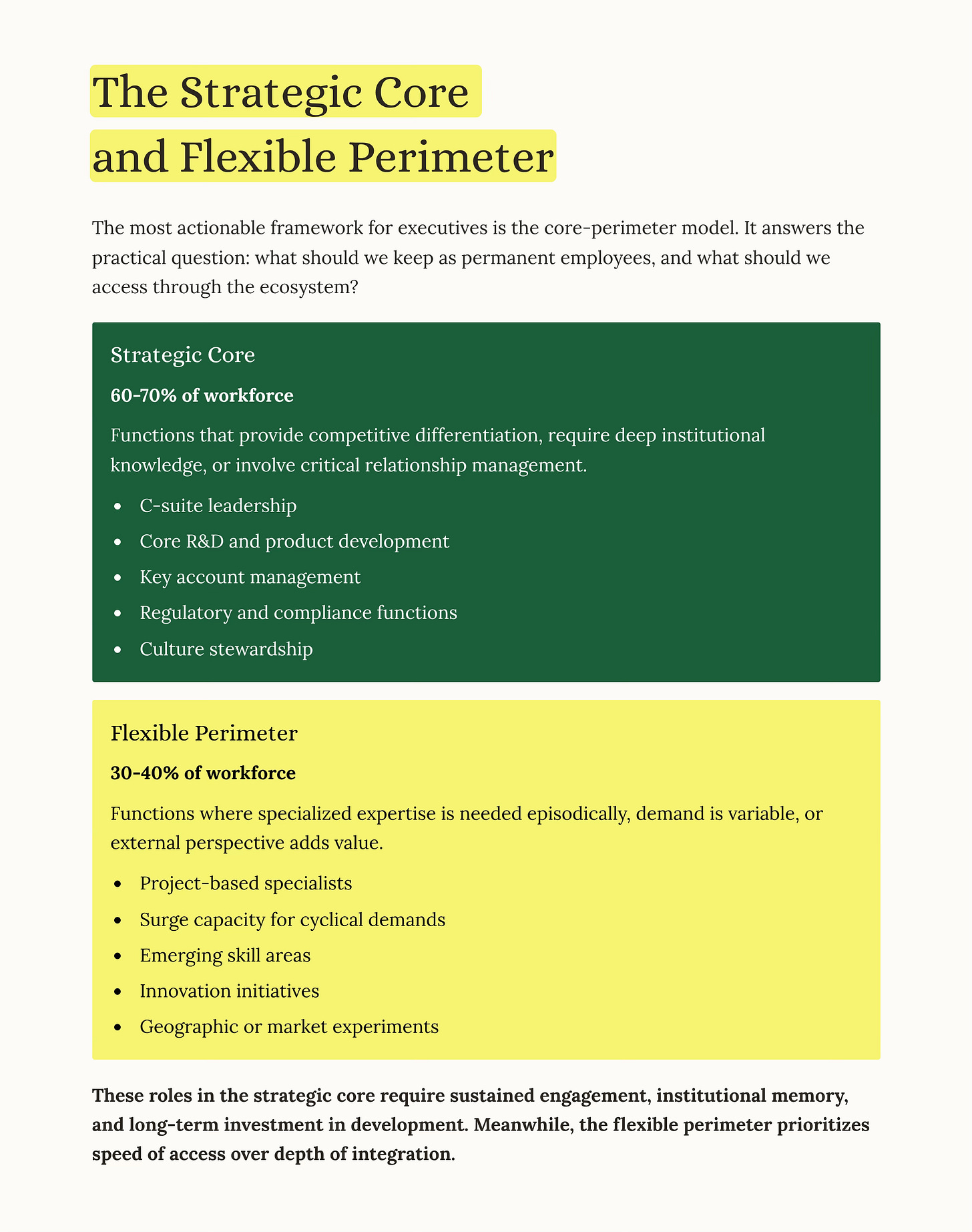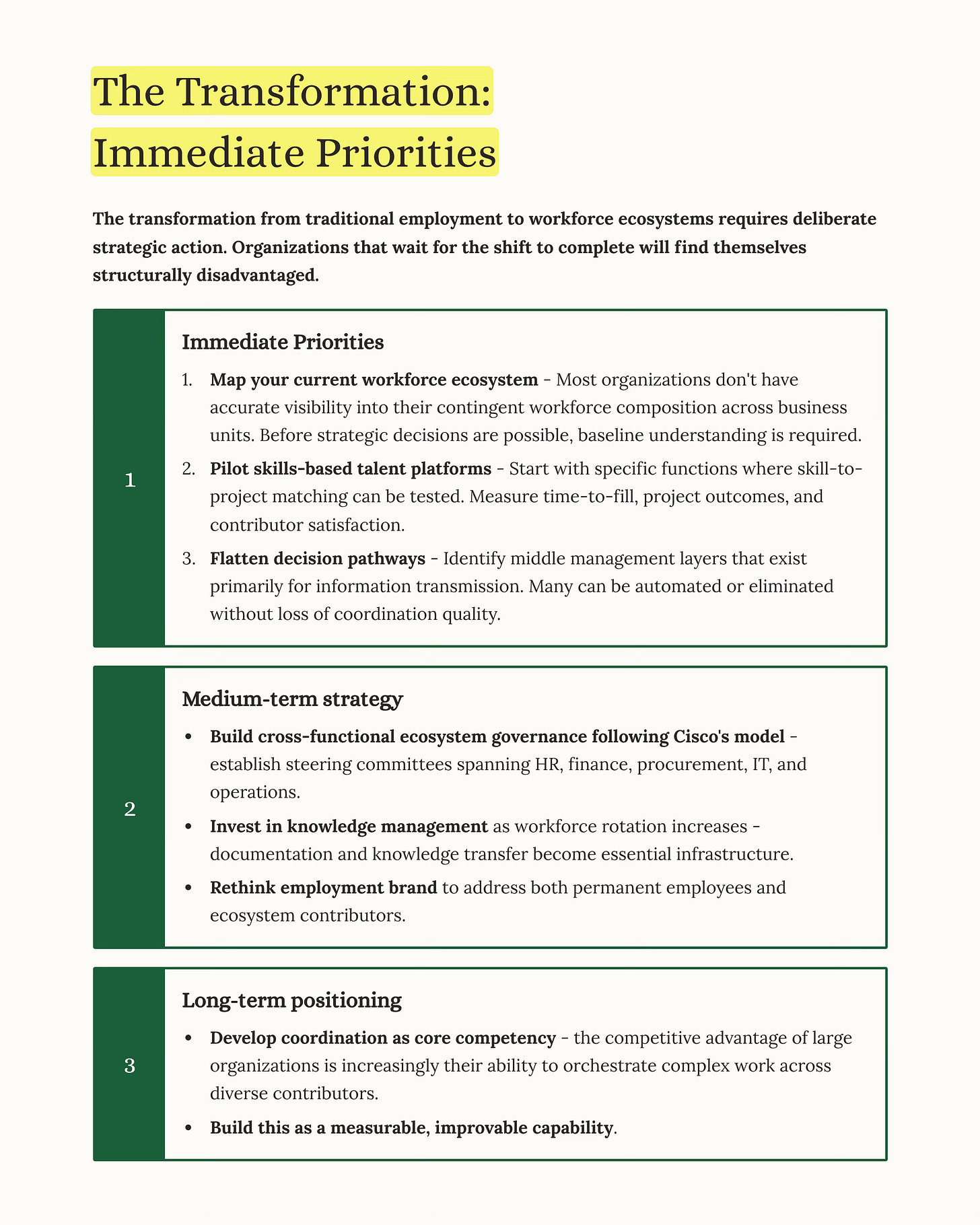The Future of Companies: How Large Enterprises Are Evolving Beyond the Corporate Job
The Enterprise Adoption of the Gig, Creator and Contractor Economies
Check out these reader favorites:
A Narrative Problem
The narrative is everywhere: corporate jobs are dying. AI is eliminating positions. The traditional career is obsolete. Millions of workers will become independent creators, freelancers, gig workers, anything but employees.
This narrative is partially correct and profoundly misleading.
What’s actually happening is more interesting and more consequential. Large enterprises aren’t disappearing. They’re reorganizing: workforce ecosystems that blend permanent employees with fractional specialists, contractors, and platform-based talent. MIT Sloan research defines these ecosystems as:
“Structures consisting of interdependent actors, from within the organization and beyond, working to pursue both individual and collective goals.”
More than 75% of managers now view their workforces in this way, as a combination of employees and non-employees rather than purely internal headcount.
The implications for business strategy, organizational design, and competitive advantage are manifold. This is a new operating model that requires understanding and deployment.
The Convergence of Three Economies
Three distinct workforce models have emerged over the past decade. They’re now converging into a single ecosystem that large enterprises must understand.
The gig economy began with task-based, platform-mediated work. Drivers, delivery workers, and service providers matched with customers through apps. The model demonstrated that work could be disaggregated from employment. Workers outside traditional employer relationships could complete tasks. Harvard Business Review research found that autonomy and flexibility were primary motivations for gig workers, not merely economic necessity.
The creator economy extended this principle to knowledge and expertise. Professionals began documenting their capabilities on LinkedIn and across primary blogging platforms, building reputations through content, and treating their personal brand as a professional credential. What appeared to be influencer culture was actually the emergence of a B2B reputation infrastructure. Harvard Business School research confirms that personal branding has become essential professional currency. It is a mechanism that enables opportunity discovery.
The contracting economy represents the mature form. Portfolio careers, fractional executives, and multi-company engagements now characterize how a significant portion of knowledge workers operate. Harvard Business School’s Project on Managing the Future of Work communicated that 60% of business leaders expect their core workforce to become “much smaller” in the future, with companies increasingly choosing to “rent, borrow, or share talent” rather than employ it directly.
These three models share a common architecture:
Disaggregation of work from employment
Platform-enabled matching between talent and opportunity
Reputation systems that enable trust without institutional affiliation
For large enterprises, this convergence creates both challenge and opportunity. The challenge is integration. The opportunity is access to talent, flexibility, and cost structures unavailable under traditional employment models.
The Workforce Ecosystem Model
The most useful framework for understanding this shift comes from MIT Sloan’s multi-year research collaboration with Deloitte. Traditional workforce management assumed a clear boundary: employees inside, everyone else outside. The workforce ecosystem model dissolves this boundary.
Organizations now operate with multiple contributor types:
Full-time Employees
Part-time Staff
Contractors
Fractional Executives
Agency Workers
Outsourced Functions
Gig Workers
Platform-Based Specialists
Each type offers different value propositions in terms of cost, flexibility, expertise depth, and institutional integration. Managing this ecosystem requires fundamentally different capabilities than managing a traditional workforce.
Cisco Provides a Useful Benchmark
The company operates with 83,000 full-time employees and more than 50,000 contingent workers—roughly 38% of its total workforce. Cisco has implemented cross-functional steering committees spanning finance, HR, IT, and operations to coordinate this blended workforce. The company treats contingent workforce management as a strategic function, not an administrative convenience.
This ratio, roughly 60-65% permanent core, 35-40% flexible perimeter, appears consistently across leading enterprises. Harvard research confirms the pattern: organizations are deliberately shrinking their permanent headcount while expanding their access to external talent through platforms and contracting relationships.
Permanent employees provide institutional knowledge, cultural continuity, strategic thinking, and depth of relationships. They’re essential for functions that require sustained engagement: leadership, core product development, key customer relationships, regulatory compliance. Contingent workers provide specialized expertise, variable capacity, diverse perspectives, and cost flexibility. They’re optimal for project-based work, cyclical demand, skill gaps, and innovation initiatives requiring external viewpoints. Where the work of a single role used to require 40 hours, and now requires less time commitment, this flexibility will become a requirement for enterprise decision-makers.
Organizational Structure:
Flat, Distributed, and Hybrid
The workforce ecosystem model requires corresponding changes in organizational architecture. Traditional hierarchies with seven to twelve management layers struggle to efficiently coordinate blended workforces that span internal and external boundaries.
MIT Sloan research on distributed leadership addresses this directly. Professor Deborah Ancona’s work defines distributed leadership as “collaborative, autonomous practices managed by a network of formal and informal leaders across an organization.” The research concludes that command-and-control bureaucracies are too rigid to keep pace with the coordination demands of ecosystem management.
Successful organizations are flattening, not eliminating, hierarchy. The shift is from deep pyramids to shallow networks. Decision-making pushes lower. Spans of control widen. Middle management layers, focused purely on information transmission and approval routing get eliminated, often by AI. Fortune reports that companies like Amazon, Moderna, and McKinsey are already eliminating middle management layers as AI handles coordination tasks.
Harvard Business School research on self-managing organizations found that 79% of Fortune 1,000 companies and 81% of manufacturing organizations now deploy “empowered,” “self-directed,” or “autonomous” teams.
The flat organization isn’t an end state. It’s an enabler. Flatter structures allow organizations to coordinate across ecosystem boundaries (integrating contractors, fractional workers, and platform talent) without the bureaucratic overhead that makes such coordination prohibitively slow. The MIT Sloan Management Review confirms that reduced hierarchy attracts workers who thrive on autonomy, precisely the workforce profile that ecosystem models require.
The Strategic Core and Flexible Perimeter
Harvard’s research on skills-based hiring provides supporting evidence for this model. When companies genuinely commit to skills-based approaches, what researchers call “Skills-Based Hiring Leaders.” They see measurable results: workers hired based on skills rather than credentials show retention rates 10 percentage points higher than traditional hires.
The core-perimeter model also addresses the “hollowing out” critique. Critics argue that excessive contingent reliance erodes institutional knowledge and cultural coherence. Wharton research confirms: poorly integrated temporary workers can hurt performance by reducing regular employees’ identification with their workplace.
The solution is to maintain a robust permanent core while integrating contingent talent deliberately. Organizations fail not by having too many contractors, but by failing to invest in integration, clear onboarding, cultural inclusion, knowledge management systems, and aligned performance expectations.
The Business Case:
Costs, Agility, and Innovation
Traditional organizations form cross-functional teams in six to eight weeks. Ecosystem-enabled organizations do it in one to two weeks, a 75% improvement in team formation speed. Traditional organizations run 18-24 month innovation cycles. Ecosystem organizations, accessing specialized external talent for specific initiatives, compress cycles to 9-14 months.
Stanford research on AI and the future of work adds nuance to the discussion. Workers themselves want AI and flexible arrangements for specific purposes: handling repetitive tasks so they can focus on meaningful work. Only 17% want AI handling creative work, citing the “absence of human touch” as critical. The implication is that blended models should deploy technology and contingent talent for execution capacity while preserving human permanent staff for judgment, creativity, and relationship depth.
Synthesis: Organizations that master ecosystem orchestration gain access to talent their competitors can’t hire, flexibility their competitors can’t match, and innovation velocity their competitors can’t sustain.
Talent Platforms and Skills-Based Management
The infrastructure enabling workforce ecosystems is maturing rapidly. Talent marketplace platforms, internal and external systems that match skills to opportunities, represent an $8.2 billion global market projected to reach $15.1 billion by 2031.
These platforms use AI-powered matching to connect verified skills with project needs. The shift from credential-based to skills-based talent management is fundamental.
Traditional Hiring Asks: “Where did you go to school? Where did you work?”
Skills-Based Hiring Asks: “What can you do? How well can you do it? Can you demonstrate it?”
Harvard Business Review research found that skills-based approaches are spreading, albeit more slowly than corporate pronouncements suggest. But where genuine commitment exists, results follow: 25% average salary increases for workers hired into previously degree-requiring roles without degrees.
Gig worker research on flexibility quantifies why workers choose portfolio arrangements. The study found that flexibility has substantial monetary value: forcing the average worker out of their preferred schedule is equivalent to a 5.3% reduction in weekly earnings. For some workers, the ability to start or stop working at any moment was valued at a pay premium equivalent to 17%.
Workers may rationally choose fractional arrangements even at lower total compensation because flexibility itself has genuine utility value.
For large enterprises, the strategic imperative is platform adoption. Organizations without sophisticated talent marketplace capabilities will struggle to access ecosystem talent efficiently. They’ll rely on slower, more expensive staffing agencies. They’ll lose access to elite specialists who prefer fractional work. They’ll face a competitive disadvantage in talent markets that increasingly favor platform-mediated matching.
Integration, Risk, and the Limits of Flexibility
Workforce ecosystems create genuine risks that must be managed deliberately.
Misclassification liability represents the most direct legal risk. Worker misclassification penalties include back wages, unpaid taxes, benefits obligations, and substantial fines. As contingent relationships become more sustained and integrated, the legal distinction between contractors and employees becomes increasingly contested. Organizations need a robust compliance infrastructure and clear contractual boundaries.
Erosion of institutional knowledge represents a strategic risk. When 35-40% of your workforce rotates regularly, knowledge capture and transfer become business-critical. Wharton research identifies that poorly integrated contingent workers can reduce performance. The antidote is investment in knowledge management systems, documentation practices, overlap periods for transitions, and deliberate cultural integration of non-permanent contributors.
Cultural fragmentation represents the organizational risk. Permanent employees may resent contractors. Contractors may feel excluded from organizational community. The solution is inclusive practices: unified onboarding, shared performance expectations, integrated collaboration tools, and leadership that treats ecosystem contributors as full team members regardless of employment status.
Researchers at MIT Sloan found that only 30% of organizations feel prepared for managing a blended workforce. This gap between ecosystem adoption and ecosystem capability represents both competitive risk and competitive opportunity. Organizations that invest in integration infrastructure, encompassing technology, processes, and culture, will outperform those that hire more contractors without changing their management approach.
Recommendations for Enterprise Leaders
Concluding Thoughts
The “death of the corporate job” narrative misunderstands what’s happening. Corporate jobs aren’t dying. They’re differentiating into strategic core roles that require permanence and flexible perimeter roles that benefit from ecosystem access.
Large corporations aren’t becoming obsolete. They’re becoming platforms, organizations whose competitive advantage lies in their ability to coordinate talent, integrate diverse contributors, and orchestrate complex work across boundaries.
This actually favors large enterprises. Scale provides resources to invest in talent platform infrastructure. Brand provides credibility to attract ecosystem contributors. Network effects provide matching advantages that compound over time. BCG research on fractal organizations confirms that the organizations best positioned to win in a workforce ecosystem world are often the same large enterprises that dominated the traditional employment world, if they choose to adapt.
The winners will be organizations that treat this transformation as a strategic priority, not a siloed administrative or HR matter. Those companies that invest in integration rather than simply accessing cheaper labor, that build coordination capability as deliberately as they built manufacturing capability a generation ago will be the organizations business schools lionize for the next generation.
The corporate job is evolving. The question for enterprise leaders is whether they’ll lead the evolution or be disrupted by it.
- john -
Operating by John Brewton goes deep on what it takes to build, scale, and optimize modern companies. This breakdown analysis is just the starting point. Check out last week’s analysis of Amazon’s current operating strategy to see more.
Research Sources
MIT Sloan: The Future of Work Is Through Workforce Ecosystems
MIT Sloan: Manage Your Workforce Ecosystem, Not Just Your Employees
MIT Sloan: Why Distributed Leadership Is the Future of Management
MIT Sloan: People Follow Structure—How Less Hierarchy Changes the Workforce
Harvard Business School: Being the Boss—Gig Workers’ Value of Flexible Work
Deloitte: The Case for Integrating Management of Contingent Workers
John Brewton documents the history and future of operating companies at Operating by John Brewton. He is a graduate of Harvard University and began his career as a Phd. student in economics at the University of Chicago. After selling his family’s B2B industrial distribution company in 2021, he has been helping business owners, founders and investors optimize their operations ever since. He is the founder of 6A East Partners, a research and advisory firm asking the question: What is the future of companies? He still cringes at his early LinkedIn posts and loves making content each and everyday, despite the protestations of his beloved wife, Fabiola, at times.









remember when net capacity, head count, was so important, things have definitely changed, you have to think about the impact beyond just how many people you have on the roster
As software & AI eats into Services - many of the employees will resemble gig workers ie lawyers completing the task that's 99% been executed digitally. Super interesting article John - thanks for sharing 🌞